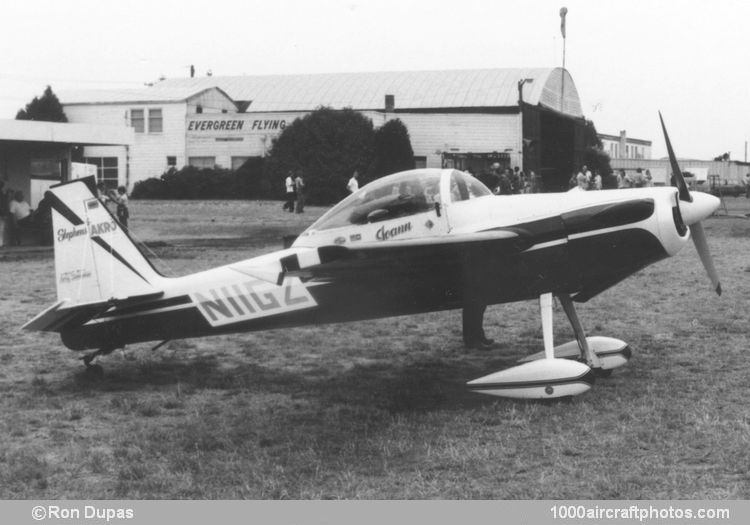06/30/2010. Remarks by Johan Visschedijk: "Clayton L. Stephens, an aeronautical engineer of San Bernardino, California, and owner of the fixed-base operator Stephens Aircraft at Flabob Airport in Rubidoux, was asked by the 1966 US National Women's Aerobatic Champion, Margaret Ritchie, to design a single-seat aerobatic aircraft to replace her clipped-wing Taylorcraft. Assisted by Ed Allenbaugh and Margaret Ritchie's husband, George, Stephens began design in July 1966, construction of the prototype began a month later.
Stressed to + 12g and -11g, it was the first US aircraft known to be designed around the Aresti Aerocriptografic System for competitive aerobatics. (Also simply known as the Aresti system, it was originally developed by the Spanish aerobatic ace Josť Louis Aresti in order to write aerobatic maneuvers, figures and sequences down on paper so that other people could read, fly and judge them a universal 'language'.) All control surfaces were fully static-balanced and the entire aircraft came very close to being aerodynamically symmetrical.
The all-wood flapless wing had a NACA 23012 section, with no dihedral, incidence or sweepback, while the ailerons had a steel spar, spruce ribs and were fabric covered. The fuselage had a welded steel-tube structure with Ceconite (plastic fabric) covering, while the tail unit had a wire-braced welded steel-tube structure with fabric covered swept surfaces. Power plant was a 180 hp Lycoming AIO-360-A1A four-cylinder horizontally-opposed air-cooled engine.
Registered N3859 (c/n 001) and designated Akro, the aircraft first flew on July 27, 1967, and at the US National Aerobatic Championships at Reno, Nevada, in September 1967, Margaret Ritchie placed second. However, on May 7, 1968, after 118 hours in the Akro, Margaret Ritchie was killed when she crashed at Sunnymead, California, due to g-LOC (g-induced loss of consciousness) at low altitude; the aircraft was destroyed.
A second Akro was designed for Dean S. Engelhardt of Garden Grove, California, this was fitted with wings and ailerons of increased area and reduced fuel tankage, and registered N6009N (c/n 002B) it first flew July 9, 1969. Plans were made available to amateur constructors and an unknown number have been constructed, however, the pictured aircraft was the first completed.
N11GZ was built by Gerry Zimmerman of Arvada, Colorado, and first flew in April 1971, with Gerry Zimmerman at the controls. In 1976, Zimmerman sold the Akro to Joann Osterud, a local aerobatic and airline pilot who changed the registration in 1978 to N78JN (to reflect her then-married name of Joann Nottke) and named it "Juliet" (from the 'J' in the Akro's registration). Osterud flew the Akro in hundreds of airshow performances till 1994, when she donated it to the Museum Of Flight, Seattle, Washington.
N78JN is one of the few Akros still in original configuration, and the same red-white-and-black color scheme originated by Zimmerman. The Akro design has been modified by a number of people, including Gerry Zimmerman, Leo Loudenslager, Henry Haigh, Zdeněk Stejskal, and William Zivko, culminating in an aerobatic aircraft family to which the name Laser has become a generic term. A number of these modified aircraft were (and are) still registered as Stephen Akro's."
